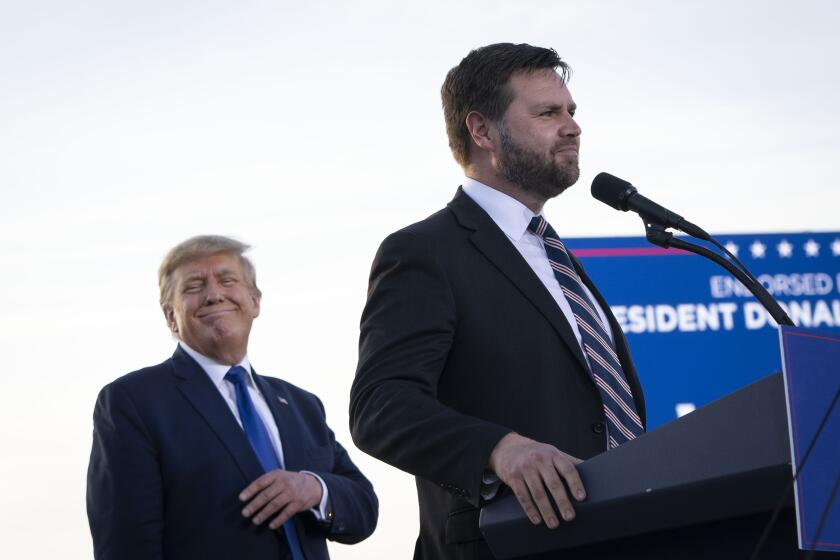Op-Ed: L.A. plays it cool on a hot night in Little Tokyo
Sunday night, I went with my kids to Little Tokyo to get sushi at a place we like. Because it’s often hard to get seated at the restaurant, we timed it carefully, aiming to arrive no later than 7. These are the accommodations one makes in a city, the edge that knowing a place can bestow. It worked, too — as did the decision to avoid 2nd Street, with its subway construction, and come up to San Pedro from 6th instead.
For all our planning, however, the city didn’t make it easy. Several police cars greeted us at the corner of 2nd and San Pedro. “What’s going on?” my daughter murmured; she turned to her phone to find out while I pulled into an open parking space beside the DoubleTree Hotel.
Then my son, who had come downtown separately, called to say he couldn’t get across 1st Street, blocked by yellow tape. “It must be a shooting,” he said, even as my daughter turned up the first reports on social media: “No,” she corrected him, “it’s a hostage situation.” Wait, she added, reading further, there were no hostages. Instead, some sort of confrontation had turned into a standoff in the Japanese Village Plaza.
When you’re faced with deployed police and a “situation,” you can stay or you can go. We stayed. And we were not alone. The night was warm and the sidewalks were crowded. The feeling was less standoff than summer festival.
On 2nd Street, a truck sold cold boba drinks. People drank them as they walked and watched the action. Or more accurately, the inaction — police officers standing in loose clusters, small crowds milling at the not-quite-barricades, chattering, taking pictures on their phones. Many of the bystanders were in costume, in town for the Anime Expo at the convention center. We were next to a young man in full Kylo Ren regalia and a woman with large, made-up eyes and a raccoon tail.
I thought of “Blade Runner,” the 1982 film about a dystopian Los Angeles in 2019; in other words, about the city we live in right now. But “Blade Runner” portrays a divided L.A., in which the symbols are all of breakdown, and the streets Sunday night felt a lot less fraught. There was no particular sense of risk, no tension — perhaps because the man the police had cornered had a knife, not a gun.
These days, Los Angeles is more coherent or cohesive, a city still beset by differences and divisions but also with a growing texture of community.
The thing to remember about “Blade Runner” is that it is not really a future vision; it may take place in 2019 but it is a portrait of Los Angeles in the 1980s, not today. These days, Los Angeles is more coherent or cohesive, a city still beset by differences and divisions but also with a growing texture of community. It is hard to define this exactly, where it comes from, what it means. I think it has to do with our emerging sense of public space, of the city as a territory that, sometimes despite ourselves, we share. Maybe it’s also part of an inevitable maturation, Los Angeles coming to terms with itself.
I’m reminded of David Wyatt’s description of San Francisco in the wake of the 1906 earthquake. It was, he wrote in his history “Five Fires,” “a city acting casual.” Borrowing a line from another writer, he clarified that: It was acting “casual when you knew [it] wasn’t feeling so.” That sense of cool, of competence, gets at how Los Angeles has come to feel to me.
Sunday night, everyone seemed in the know. Events unfolded; my son and daughter and I ate sushi in a restaurant full of undeterred patrons, at a table next to a woman in whiteface, wearing tights and a top overlaid with the pattern of a skeleton. When we came out again onto 2nd Street, the cops and the anime fans were still gathered at the yellow tape.
There’s a whisper here — I’ll admit it — of an earlier, more clichéd Los Angeles, the one where people hung over freeway overpasses gawking at the slow-speed O.J. Simpson chase. But that was all about a kind of spectacle, this was something more contained. A police standoff, an anime convention, dinner with the kids: the life of the city on a Sunday night.
David L. Ulin is a 2015 Guggenheim Fellow and the author of “Sidewalking: Coming to Terms with Los Angeles.”
Follow the Opinion section on Twitter @latimesopinionand Facebook
More to Read
A cure for the common opinion
Get thought-provoking perspectives with our weekly newsletter.
You may occasionally receive promotional content from the Los Angeles Times.











